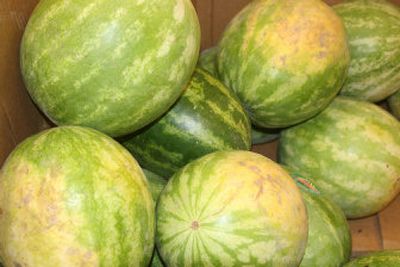They keep getting better

Plant scientists are reinventing the watermelon, that most traditional of all summertime fruits. New “mini” varieties fit easily into refrigerators. Seedless melons are easier to eat. Reduced-sugar hybrids a year or so from production will appeal to dieters and diabetics.
“Watermelon is just not for summer picnics anymore,” says Leslie Coleman, director of communications for the National Watermelon Promotion Board in Orlando, Fla. “Because of the year-round availability and the health benefits – not to mention the great taste – it makes sense to have watermelon on the table for breakfast, lunch, dinner, dessert or a snack.”
Watermelons ripen during the sweltering heat of mid-summer – perfect timing for a sweet and hydrating fruit made up of 92 percent water.
“You think of it (when you’re) hosting parties,” Coleman says. “You go into the grocery store and see watermelons splashed all over the place. It conjures up good memories.”
But times change, people change and what families want from their watermelons is changing, too.
“There’s a movement by the watermelon industry and shippers toward bonding with consumer needs,” Coleman says. “There are more households now with fewer people so they’re well served by the smaller sized melons.”
Along with requiring less storage space, the smaller melons are portable. They can be carried whole to the lunchroom or job site and sliced there into bite-sized pieces, making for a fresh and refreshing treat.
There are believed to be more than 100 watermelon varieties at present, ranging from the familiar “Charleston,” which matures at around 25 pounds, to the icebox-sized “Yellow Baby,” a yellow-fleshed variety. Seedless melons like the “Triple Sweet” are popular but require more management in the garden, particularly with pollination.
Watermelons are frost-fragile plants, so plant them in full sun and well after the soil warms. Depending upon size and variety, melons mature in 70 to 85 days. Mulching with black plastic sheets inhibits weeds, holds moisture and speeds growth.
Watermelons grow large, 5 to 100-plus pounds, so give them plenty of room – as much as 6 feet between plants.
Harvesting can be tricky. Thumping a melon with your knuckles to elicit a soft hollow thud is a popular test for ripeness, but more certain is rolling the melon over for a look at the “ground spot.” If the patch where the melon rested on the ground is light green or white, then the melon isn’t ripe. Wait until it turns a dull yellow or creamy before cutting it from the vine.
Melons should be stored on the warm side when brought into the home. “Compared to most fruits, watermelons need a more `tropical’ climate – a thermometer reading of 55 degrees Fahrenheit is ideal,” the National Watermelon Promotion Board says. “However, whole melons will keep seven to 10 days at room temperature. Store them too long and they’ll lose flavor and texture.”
Many of us prefer eating our watermelons chilled, but watch how low you go. Temperatures too cool will damage the fruit.
“After two days at 32 degrees, watermelons develop an off-flavor, become pitted and lose color,” the Promotion Board says. “Freezing causes rind to break down and produces a mealy, mushy texture. Once a melon is cut, it should be wrapped and stored at 37 to 39 degrees.”